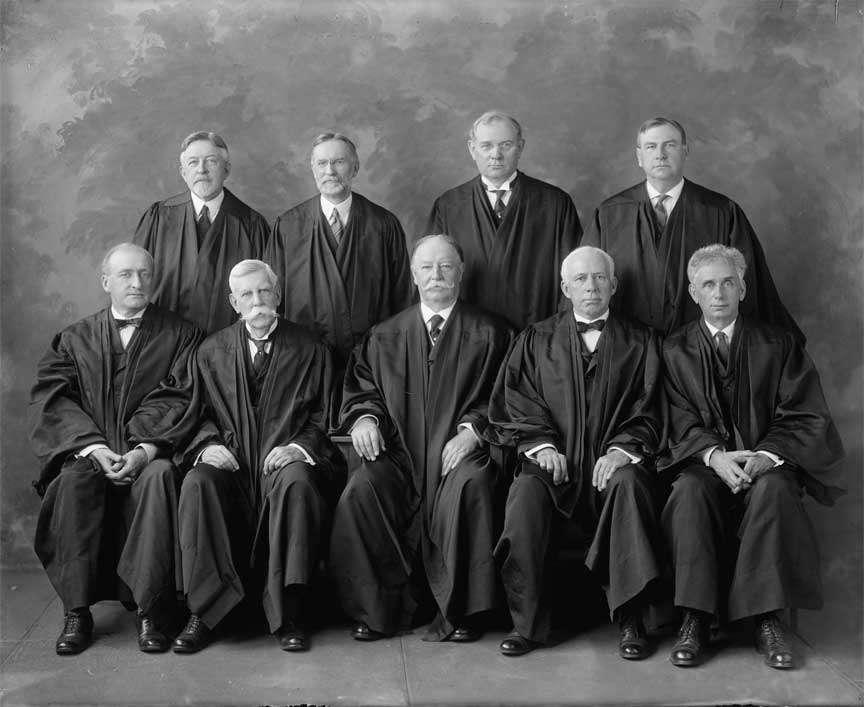Roosevelt and the Court

-
FDR Signing
President Roosevelt was frustrated by a conservative court which had found critical elements of his legislative agenda unconstitutional. FDR considered a number of options including increasing the number of Supreme Court Justices. However, in the end, time did its thing and justices retired, and FDR was able to appoint 8 of the nine justices.
Roosevelt’s concern regarding the Supreme Court began in 1935– when the court first ruled that aspects of the N.I.R.A. were unconstitutional. The sitting Supreme Court, (most of whose members had been appointed by Republican Presidents), was largely conservative, and considered to favor businesses. At that time, the Supreme Court consisted of: 4 committed conservatives, 3 clear liberals, a Chief Justice, (who was in the middle), and Justice Roberts (who Roosevelt considered a conservative, but would soon surprise FDR and change history.)
President Roosevelt felt that despite the mandate he received with his reelection, the Supreme Court would likely thwart his efforts. Through their overly narrow interpretation of the Constitution the Court found many of the laws of the New Deal unconstitutional. One of the key issues that stood before the Court was the interpretation of the ‘Commerce Clause’ of the Constitution. Chief Justice John Marshall had first used the ‘Commerce Clause’ to extend the power of the Federal government. The Supreme Court had taken the approach that ‘commerce’ only applied to commerce that was clearly tied to Interstate commerce– e.g. like railroads– to strike down the New Deal Legislation. Thus, any further attempt to regulate other commerce would be unconstitutional.
FDR had several options. He could: 1. choose to ask for a Constitutional amendment (though he felt that would take too much time), 2. elect to wait for nature to take its course (however, he quipped the justices would probably live to be a 100), 3. simply request an increase in the number of Court Justices– something that had happened a number of times in the past. Instead, Roosevelt decided on a course that was a little too clever. FDR promoted a plan to add one new justice for every justice who reached the age of 75 and had served for at least 10 year (who had chosen not to retire). Roosevelt’s flawed rationale was that the Supreme Court was not keeping up with its necessary workload. He used the absurd logic that of the 803 cases submitted to the Supreme Court, the Court had only heard 108 arguments. (Note: In 2009, the Supreme Court was asked to review 7,500 cases and only agreed to hear 93.) The Congressional response to Roosevelt’s plan was not enthusiastic. The legal community came out against his proposition outright. Supreme Court Chief Justice Hughes took the unprecedented step of writing a letter to Congress in opposition to Roosevelt’s proposal.
What ultimately doomed Roosevelt’s Supreme Court proposal was the fact that Justice Roberts had become the swing vote. Justice Roberts began to uphold New Deal legislation. The judicial tides turned with a series of decisions– starting with a decision that upheld New York Minimum Wage Law, followed by a case that upheld the Wagner Labor Relations Act, and led to another case that upheld Social Security Act. This ended the direct attempt of the Court to interfere in Roosevelt’s legislative program. Roosevelt was unable to change the Supreme Court’s make up directly. However, the Supreme Court had bent to reflect the times.
Roosevelt lost his initial battle to transform the Court. However, given his lengthy term as President, FDR was able to appoint 8 of the 9 members to the Supreme Court. Thus, Roosevelt was able to slowly change the make up of the court, keeping within the guidelines of the Constitution.
 >
>